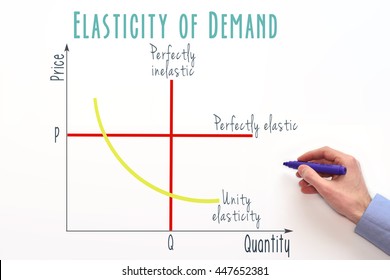Now that we are familiar with the concept of demand and the determinants of demand, let us study about another important concept – the elasticity of demand. We will be studying the meaning and the types of demand elasticity. Let’s get started.
Elasticity of Demand

(Source: ShutterStock)
The elasticity of demand is an economic term. It refers to demand sensitivity. In other words, it helps to understand how the demand for good changes is when there are changes in other economic variables. These economic variables include factors such as prices and consumer income.
Demand elasticity is calculated as the percent change in the quantity demanded divided by a percent change in another economic variable. A higher value for the demand elasticity with respect to an economic variable means that consumers are more sensitive to changes in this variable.
The elasticity of demand = (% Change in demanded quantity)/(% Change in another economic variable)
Browse more Topics under Theory Of Demand
- Meaning And Determinants Of Demand
- Exceptions to the Law of Demand
- Elasticity of Demand
- Movement along the Demand Curve and Shift of the Demand Curve
- Price Elasticity of Demand
- Income Elasticity of Demand
- Cross Elasticity of Demand
- Demand Forecasting
- Methods of Demand Forecasting
Types of Demand Elasticity
Let us take a look at the types of demand elasticity. There are broadly three types of demand elasticity.
1] Price Elasticity of Demand
This refers to the change or sensitivity in the customer’s demand for the quantity of a good with respect to a change in its price. Companies often collect this data on the consumer response to price changes. This helps them adjust the price to maximize profits.
2] Income Elasticity of Demand
This is the responsiveness of demand for a product with respect to the change in income. So it will help measure the increase or decrease in demand when the income of the consumer increases or decreases.
3] Cross Elasticity of Demand
This value is calculated by using the percent change in demanded quantity for a good and dividing it by the percent change in the price of some other good. Moreover, this indicates the consumer reaction to demand a particular good in accordance with price changes of other goods.
Demand elasticity is generally measured in absolute terms. This implies the sign of the variable is ignored. If the value is greater than 1, it is elastic. Furthermore, this implies demand is responsive to economic changes (like price). If the value is less than 1 is inelastic.
This further implies demand does not show change according to economic changes such as price. Demand is unit elastic when its value is equal to 1. This implies the value of demand moves proportionately with economic changes.
Law of Demand
Economists use the term demand as a reference to the quantity of a good or service that a consumer is willing and has the ability to purchase at a price. Demand is based on needs and the ability to pay. Ability to pay is important as in its absence the demand becomes ineffective.
The law of demand states that if all other factors remain constant, then the price and the demanded quantity of any good and service are inversely related to one another. This implies that if the price of an article increases then its corresponding demand decreases. Similarly, if the price of an article decreases then its demand should increase accordingly.
The price of the good and its price are plotted to form the demand curve. The demand quantity at a particular price can be calculated from the demand curve. This price and value relation is represented in a table known as the demand schedule.
Solved Question for You
Q: What is Ceteris Paribus?
Ans: It is important to take into account the assumptions made while constructing the law of demand. A primary assumption is ‘Ceteris paribus’. This implies that everything aside from price remains constant and no change in any other economic variable. Furthermore, the change in the demanded quantity is only due to a change in prices.






B.com 1st year
Bus.economic
ok